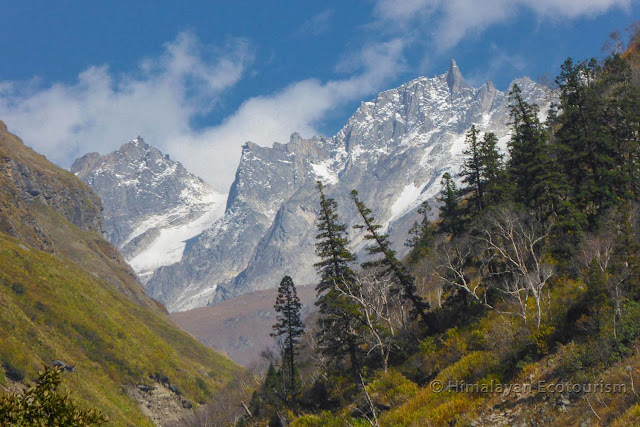Joy and sustainability in the mountains
Scaling great heights
This piece finds space in Spectrum
(Deccan Herald) on 14th October.
Thanks are due to the team at
Spectrum.
Image Credit: Himalayan Ecotourism
Four of us sat in the dimly-lit room of a restaurant
at Gushaini in Himachal Pradesh, eating noodles and momos. The discussion began
with tree planting – local tree species, tree guards, funds required ..... The
idea was to plant trees along trek routes, the routes beyond the Great
Himalayan National Park (GHNP) that today stood bereft of trees. This would also
be an apt follow-up to the awareness campaign they had taken up with Himalayan Ecotourism.
Cooperative here is the group of locals engaged in
undertaking treks in and around the GHNP, and Himalayan Ecotourism is a set-up
that helps market the
treks. Gushaini, in the lower Tirthan valley, is the
gateway to
GHNP.
At the restaurant, Sanju and Keshav shared how the cooperative
managed the treks. Stephan, of the Himalayan Ecotourism, was the 4th
person on the table.
The 65 members who formed the cooperative more or
less run the show. Depending on the needs of each trekking group, they freeze
the number of guides, porters, cooks and others (if any) needed. The
payments are made on fix rates. It’s crucial to ensure financial transparency;
in other words, keep track of each rupee that comes in and how it’s used.
Members going on the trek were aware not only about
the itinerary and dietary needs, but also the finances. They added that since most
members stay in villages with no bank branches, funds are transferred from one
member to another using Pay Tm and Google Pay.
They shared of how April had been a good month. The
number of groups they catered to were more. We had sweets over their having
recently won the Outlook
Responsible Tourism Awards – for charting a new model where
people in the locality are involved, by way of a cooperative, in decision
making and not just employed as guides. This had not only raised their morale,
but also their ‘stock’ locally. I sat in silence as the 3 of them went to the
market.
Image Credit: Himalayan Ecotourism
Long
away from home
This has not been an easy journey for either the cooperative
or Himalayan Ecotourism. They began a few years ago with the goal to provide economic
benefits to the locals and conserve GHNP. In other words, to make GHNP
beneficial for the locals beyond the ecosystem services. GHNP is a prime
repository of biodiversity in western Himalayas. This has been lucidly brought
out in a book published earlier this year - The
Great Himalayan National Park: The Struggle to Save the Western Himalayas
by Sanjeva Pandey and Anthony J Gaston – two people who have had a long
association with the landscape.
They also write of how it was one of the first protected
areas in the country where the forest department implemented a people-centric
model of conservation. A model that brought the forest department and GHNP acclaim
and international attention. It also led to setting up of multiple
institutions, collaborations with external agencies, and infusion of funds. A
number of activities were initiated. All of these took place more than a few
years ago.
Himalayan Ecotourism and the cooperative came
together at a time when these efforts had begun to age. They had to take
cognisance of the efforts taken up during recent past and learn from their
predecessor’s experiences – read not repeat the same mistakes.
On occasions, they also had to deal with needs and expectations
of the local people; creation of GHNP had resulted in economic loss for many of
these people.
To top this, they were not short of those wanting to
pull them down. The valley, all three of them stated, thrived on politics. The
scenario, like at many other conservation priority landscapes, was complicated.
Himalayan Ecotourism has ‘Creating joy and
sustainability in the Himalayas’ as its tagline while Stephan is referred to as
‘Tintin in the Himalayas’. Stephan has, over the years, tried developing chulas that are friendly to both the
forest and users, and running a cafe. Today he also runs a home stay in Bihar,
near Banjar (Block headquarters),
where he is based.
One evening, as we soaked in the stunning view from Stephan’s
balcony, I asked if the slopes bereft of twinkling lights were a part of GHNP.
He nodded. We discussed how he began his association with the landscape with Friends of GHNP,
his frustration with not-for-profits, to how, today, some of his actions have
got him into trouble with the local elite. He shared plans to explore usage of drones
to monitor forest fires. Forest fire is an issue he believes warrants more
attention and Himalayan Ecotourism has also taken up a campaign on this.
Image Credit: Himalayan Ecotourism
To
the present
The three of them returned and we requested the
restaurant for tea. I asked Sanju and Keshav about the cooperative’s plans.
They were hopeful that the award, would bring in more business.
Later that evening, I wondered on the fresh set of
challenges they faced. Prime among these were sustainability concerns in the
midst of burgeoning
tourism in the valley and ensuring joy and sustainability in
the co-operative.
And as I write they have initiated a crowd funding
campaign to support the tree planting. They have come a long way from the
Co-operative’s first meeting which Stephan had described. That day he was the
only one who spoke.



Excellent.
ReplyDeleteThanks Rana Saab, look forward to visiting you again soon ~
Delete